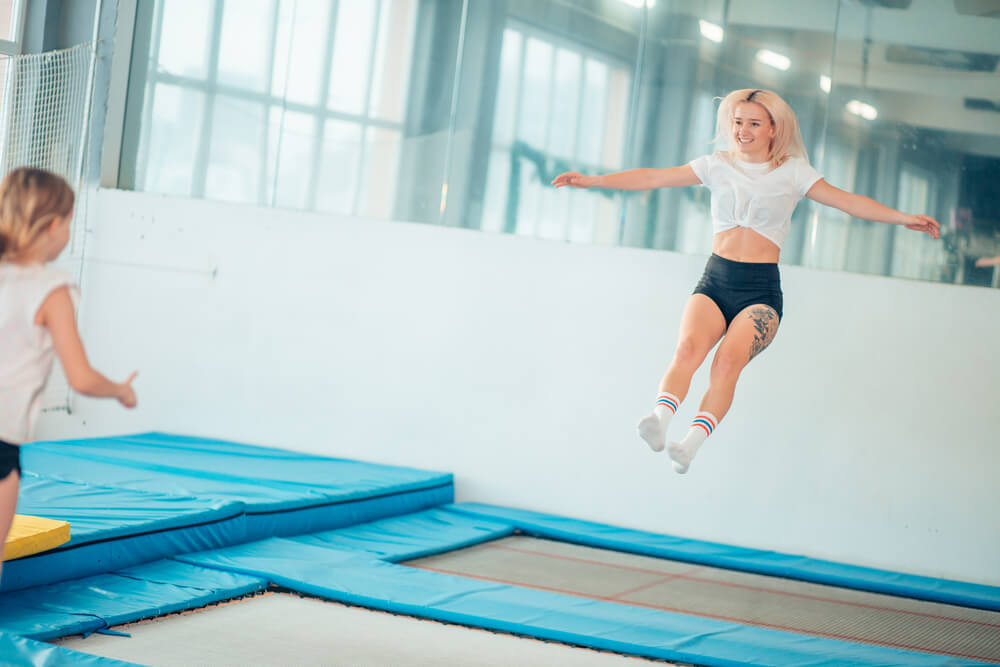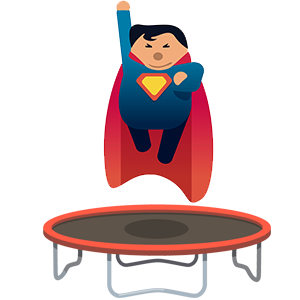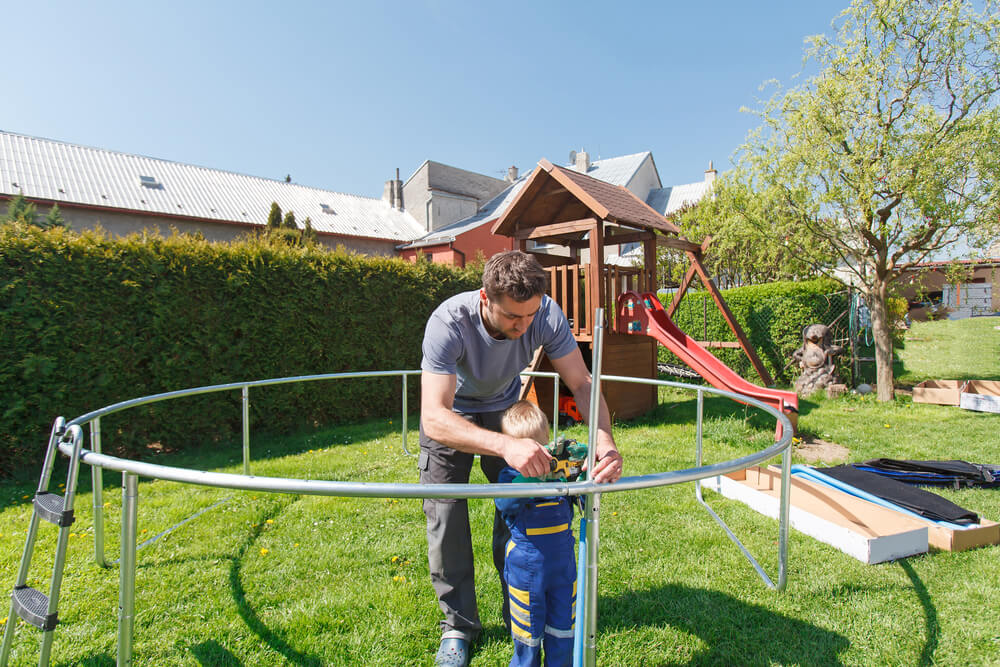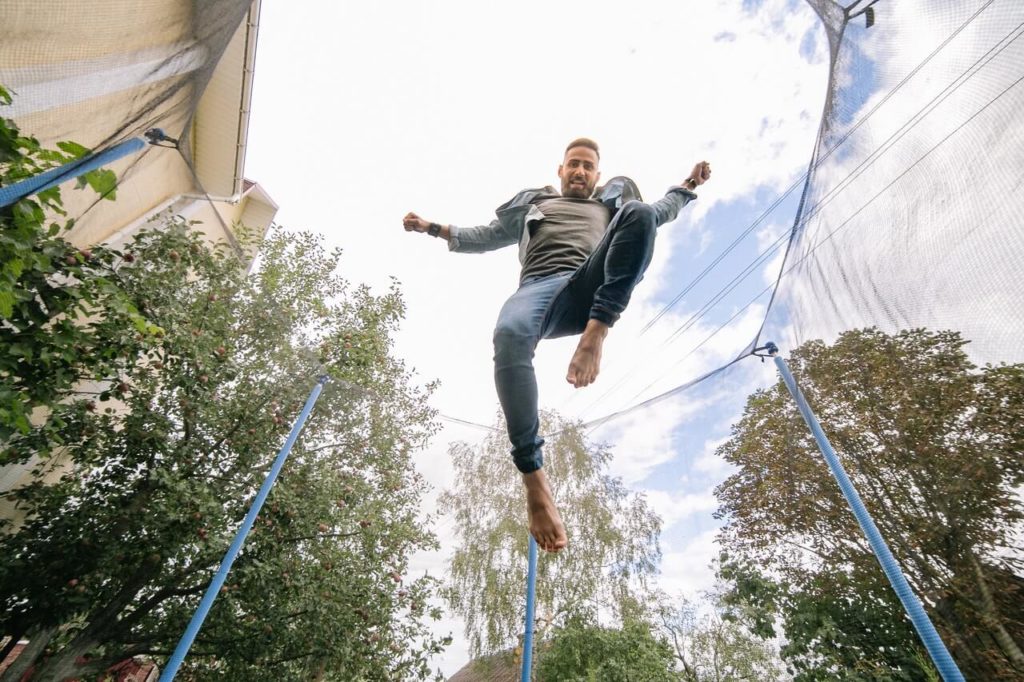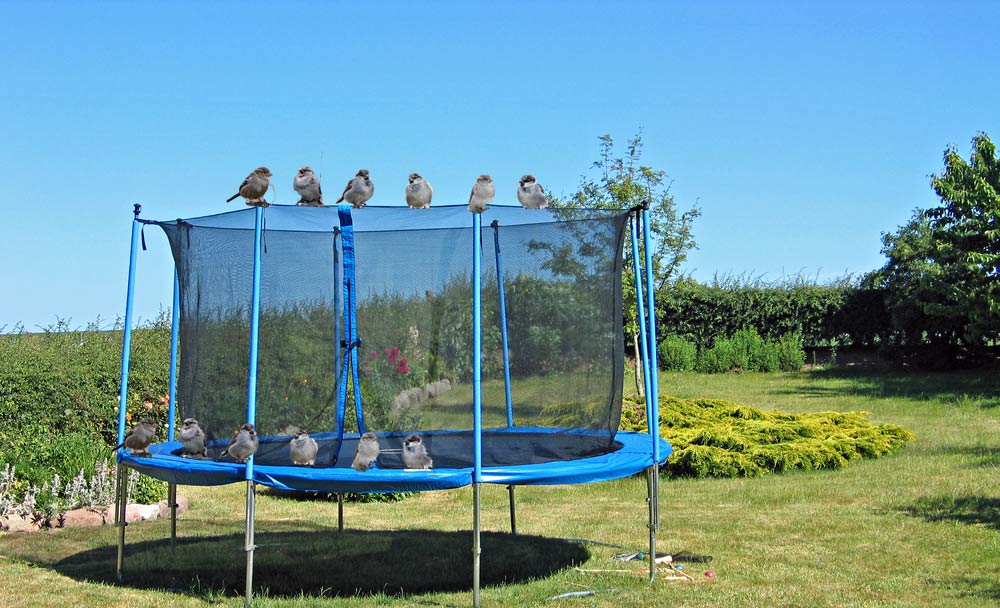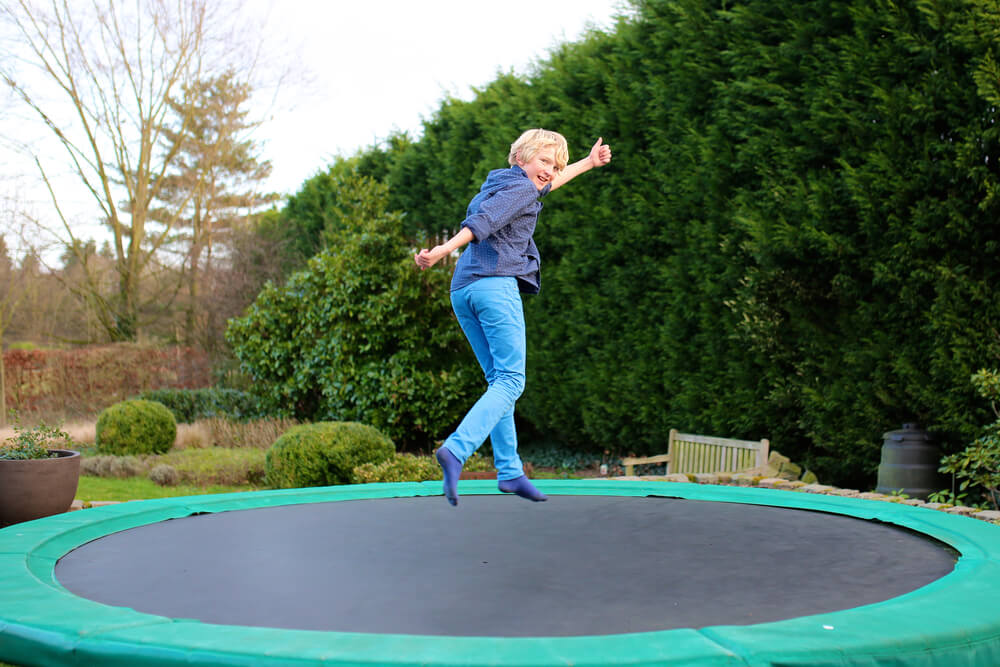Is jumping on a trampoline good for your brain? Or does it cause brain damage? Find out here.
You’ve probably heard about it.
As trampoline parks have become more prevalent in the U.S., so have trampoline-related injuries. The biggest concern: head, neck, and brain injuries.
It is terrifying. We know.
That might have you bothered that getting a full-size backyard trampoline could crack your brain. Or buying a fitness trampoline might not be worth it, after all.
Perhaps you already bought a mini trampoline for your child. And now you are racking your brain, wondering if it is a better idea to crush it.
But what’s the truth about trampoline safety?
Are trampolines that bad for your head and brain health?
This guide explores the rumors, claims, and evidence-based truths on the subject. Then you can decide what to do next.
Does jumping on a trampoline affect the brain?
Absolutely. Multiple studies have confirmed that rebounding improves balance, focus, and brain-body coordination. As you bounce, your body and brain constantly adjust countless ligaments to keep you balanced both up in the air and on landing.
There’s more
- Trampolining reduces stress
Bouncing up and down on a trampoline makes beating cortisol, the stress hormone, feel like child’s-play.
Trampoline jumping releases floods of feel-good hormones throughout your system, starting in the nervous system, which the brain heads. Endorphins, dopamine, and serotonin are excellent stress busters.
The hormones are excellent natural painkillers, too.
The body releases them during exhilarating activities. That might be in the middle of your dance class, jumping jacks, or enjoying ice cream.
Keep in mind that high-stress levels are a leading cause of heart and brain health complications such as high blood pressure and stroke.
So, trampolining can help keep your brain and body healthy.
- Bouncing is a complete workout, too.
One of the reasons rebounding is so interesting is it could be the super workout program you’ve never thought of.
NASA revealed rebound exercising was a “most effective and efficient” workout more than 40 years ago.
Several more studies have backed trampoline jumping as a great way to burn calories and lose excess weight over time.
The American Council on Exercise found rebounding for 20 minutes was as effective for losing weight as running at 6 miles per hour in a similar timeframe. The 2016 ACE report also compared jumping on a trampoline to biking at 14 miles per hour or playing basketball or football.
Findings from an 8-week study also reported that rebounding exercises were more effective at burning excess fat than running and jogging. That’s stellar news for brain health.
Remember, excess fat in all the wrong places is associated with stroke, a significant brain health scare.
- Rebounding fuels your brain.
On top of its heart health benefits, trampolining can help increase your lungs’ ability to inhale more oxygen.
That’s something you want because the higher your blood oxygen levels are, the more focussed, less-stressed, and productive you can be.
It is no surprise that the brain consumes the highest percentage of the oxygen you breathe. It needs it to keep you sane.
More oxygen to the brain can also mean fewer migraines and headaches, especially after a workout.
Oxygen-rich blood is also crucial for supporting other numerous body functions. And those benefits can linger around way long after you’ve stepped out of a fitness, backyard, or recreational trampoline.
- Jumping on a trampoline is a low-impact workout.
One of the biggest concerns people have is whether rebounding on a trampoline can kill brain cells.
The great thing about trampolines is you jump on a shock-absorbing surface. So, your brain and joints do not bear the full brunt of impacting a hard surface compared to, say, doing jumping jacks on the floor.
You are reading those benefits and probably wondering why the American Academy of Pediatricians (AAP) doesn’t recommend children jump on a trampoline more often.
Here are some answers to those frequently asked questions about trampoline safety.
We’ve covered trampoline safety tips on our guide here. Check it out for detailed trampoline safety recommendations, including the right size trampoline by weight, age, and skill level.
But Does Jumping on a Trampoline Cause Brain Trauma?
An increase in head and brain injuries from trampoline-related accidents has seen authorities such as the American Academy of Pediatricians not recommend recreational trampolines for children since 1977.
There’s a reason the AAP pinpoints recreational trampolining.
Trampoline parks tend to allow several children to bounce together. That leads to collisions.
The AAP says 75% of all trampoline injuries happen when several people are bouncing on a trampoline at once.
So, what if you feel backyard trampolining is a great way to enjoy some home-made fun with your loved ones?
Here’s the thing:
You’ll not want to encourage kids to flip or somersault on a trampoline from the beginning. You do not want to do it yourself, either.
Landing on the head can cause head, neck, and brain injury. That can happen whether you make a deliberate or awkward landing.
Now, the best trampolines for sale offer plenty of shock-absorbing power. But you do not want to tempt permanent paralysis now, do you?
So, train them to do it safely first, especially if they are aspiring gymnasts. If you can, get a professional gymnast’s advice.
Teach children six years and older to play safely.
Keep toddlers away from the bouncer altogether.
Picture this.
Young children’s brains are still growing and developing.
That makes them prone to brain trauma when disturbed significantly. So, be sure to get good-quality trampoline safety gear such as padding and enclosures.
High-quality pads can help protect your child from hitting any hard surface on the trampoline. Potential hard surfaces include:
- Safety net posts
- Springs
- The metal frame or perimeter
A good-quality enclosure will help protect your child from bouncing off the trampoline and landing on the hard ground surrounding it.
Another way to go about it is to buy a kid-friendly trampoline.
The best trampolines for children come with several advanced safety features to protect your little ones.
Those include having:
- Low-bounce
- Hold-on bar
- Trampoline-wide padding
Mini trampolines do not include enclosures. But they do come with padded frames and hold-on bars.
Trampolines that are eight feet across or larger do offer safety nets. Zipped safety nets help keep wayward bounces within the safety of a trampoline mat. It will be a worthy investment.
Otherwise, you’ll need to be around every time your kids want to bounce. And that may not always be the case.
So, start nice and easy on yourselves.
If you are new to bouncing and rebounding, keep the first two weeks’ sessions at a maximum of 10 to 15 minutes, 2 to 3 times a week.
That’ll give your brain and joints enough time to adapt.
Then you can proceed towards 10 minutes a day. Or rack up to 30-minute sessions, 3 to 4 times a week, for adult-only trampoline exercise programs.
Also, young children can get injuries from falling on hard or sharp objects they have in their pockets. So empty those pockets beforehand to keep them safe.
What trampoline injuries are bad for the brain?
No injury is good at all.
But some injuries carry higher brain trauma risk than others.
The AAP’s 2019 report shows several more common trampoline-related accidents that can cause head and neck injuries.
As mentioned earlier, collisions are the biggest headache. But they are easy to avoid. Allow only one child to use the home trampoline at a time.
Falling off a trampoline is another big problem. Medical experts recommend you install a trampoline on a firm but soft surface. It can help break a fall’s impact. And that can protect your child from getting a concussion.
You’ll also want to place the rebounder away from trees, walls, power lines, fences, plumbing works, and other obstacles. You do not want anyone hitting those.
Failed backflips and awkward somersault landings are a problem, too.
They can lead to moderate to severe neck, spine, and brain injuries. You’ll want to avoid them unless you and your loved ones are skilled at them.
Why does jumping on a trampoline hurt my head?
It is possible to experience a headache after a strenuous working out. People who do also feel them after running, weightlifting, jogging, and playing tennis. Often, the pain relieves on its own over a few minutes or hours.
If your or your child’s head still hurts 2 to 4 days later, you’ll want to visit a doctor for a thorough check-up.
Some additional signs could be symptoms of a bigger underlying issue. For instance, if you lose consciousness, vomit, or have double-vision, it can be a medical emergency. See a doctor immediately.
Why does my brain feel like it’s bouncing?
Hefty movements that make your head jerk forward, upward, downward, backward, or sideways can cause that feeling.
Perhaps you experience brain zaps at times. Could they have anything to do with rebounding?
Whenever you feel the zap, it is smart to get off the trampoline. Take your time to see how you feel after a few moments. If you get a migraine or headache, get a checkup.
It may not be any brain health complication.
Physicians have observed that people who experience brain zaps are usually coming off an antidepressant prescription.
But you may not know what could be the matter. So, until you do, take all precautions.
Is jumping on a trampoline good for mental health?
Trampolining is a joyful activity, which is excellent for reducing stress, beating mood swings, and, ultimately, keeping depression symptoms at bay.
It also helps keep brain oxygen levels high.
That’s important because sufficient oxygen levels keep brain cells alive and working optimally. Otherwise, brain cell death or damage can happen over time. And that can cause gradual brain function decline.
Some clinical trials are testing if trampoline use can help improve symptoms in children with autism.
Others are investigating whether rebounding makes children smarter.
Can jumping on trampolines help people with diabetes improve sensation in the feet?
A 2017 study involving 21 participants had interesting findings for people living with diabetic peripheral neuropathy challenges.
After a 20-week foot-care education program, participants got eight more weeks of home exercises on mini-trampolines.
The results were consistently positive in the group that used trampolines.
They were experiencing improved sensation in their feet compared to the control group. That means trampolines could help reduce the risk of foot ulceration, which can lead to mobility issues.
Is the trampoline aftereffect real?
Repetitive jump landing causes aftereffect sensations. Five separate studies conducted between 2017 and 2019 confirm it.
All findings show a change in how the feet react to jumping and landing before and after trampolining.
One of the latest studies suggests people could use trampolines to improve the muscles, flexing impulses, and neural controllers that aid mobility and lower body alignment.
Does jumping on a trampoline improve the lymphatic system?
Rebounding can help improve lymphatic drainage.
Cleansing your body of toxins can help protect your brain from elements that lead to cognitive function deterioration. And that may help people below the age of avoid dementia and Alzheimer’s disease.
If you are a senior, consult your doctor before trampolining. That way, you can tell if it will be safe for your back, bones, and spine.
Spinal injuries are especially concerning–at all ages. They can affect the brain’s abilities more profoundly than joint, muscle, and limb injuries.
Conclusion
Rebounding affects the brain in several powerful ways.
You can use trampolining to reduce your loved ones’ stress levels.
First, rebound exercises can help the brain improve your brain-body connection, focus, and balance.
You can also help loved ones maintain a healthy lifestyle with safe trampoline workout routines. You can do that whether you use an indoor mini trampoline or a full-size backyard trampoline.
And, with the right trampoline gear and attention, you can do all that without ever experiencing nasty concussions in your backyard.
Think that is a challenge you’d love to take up?
We thought so, too.
Happy trampolining!

